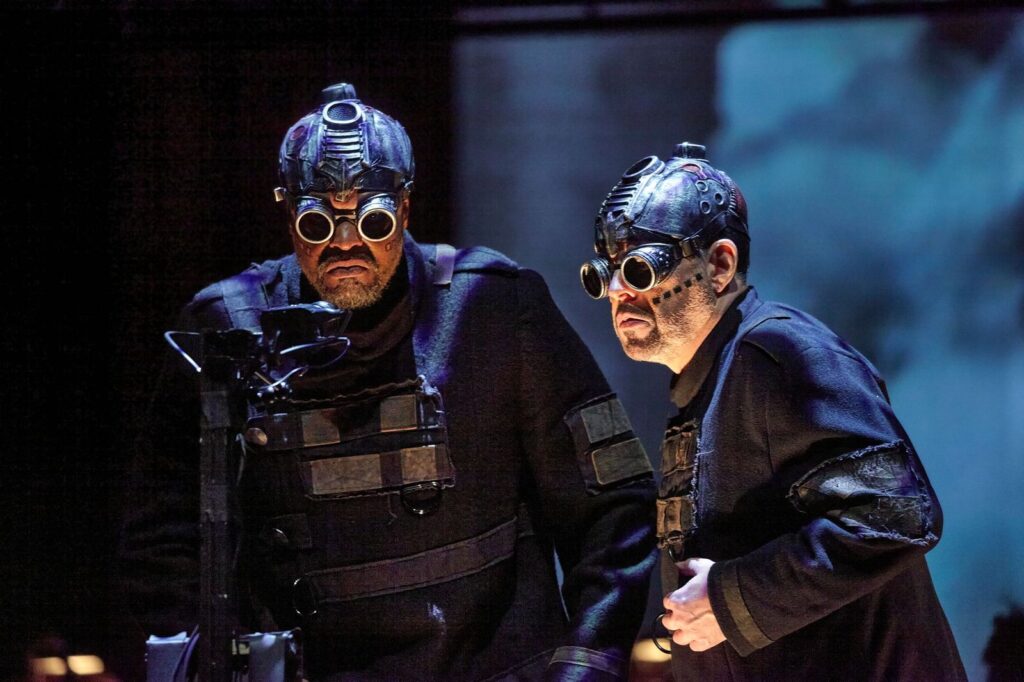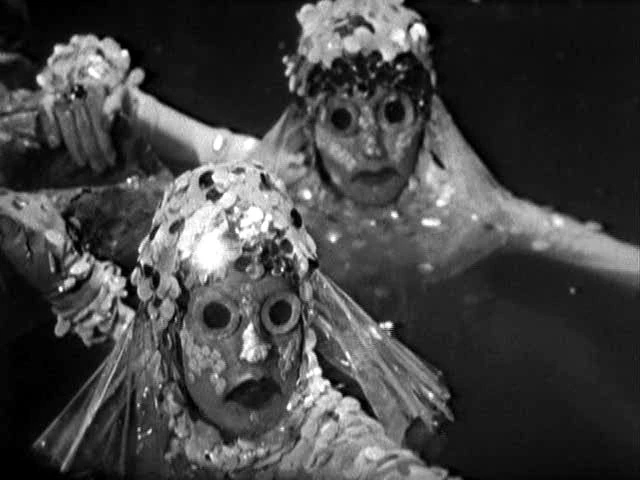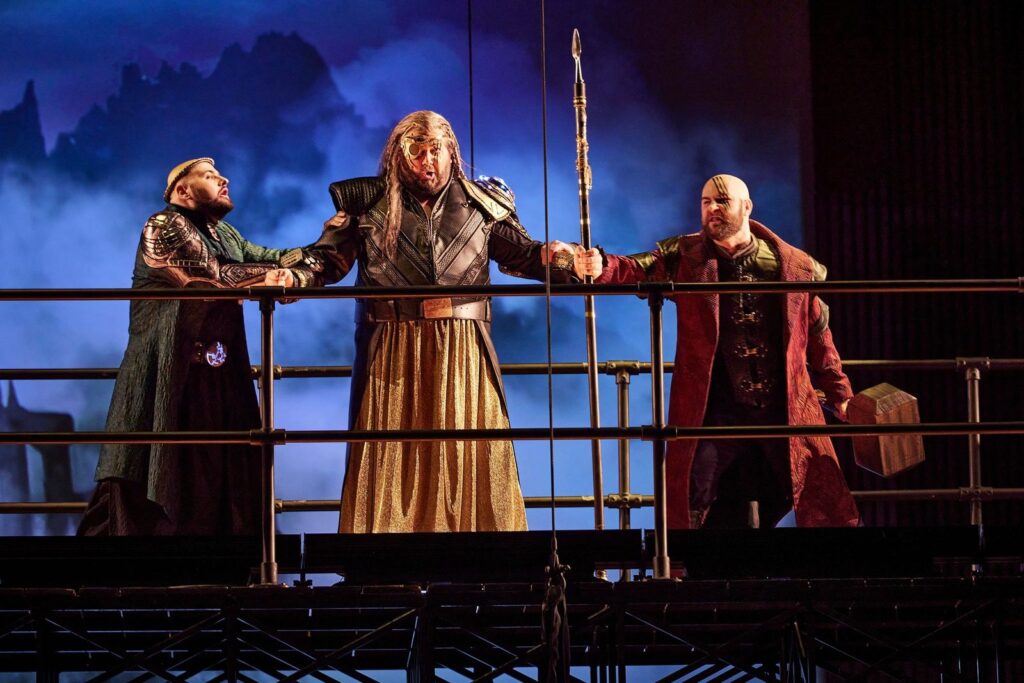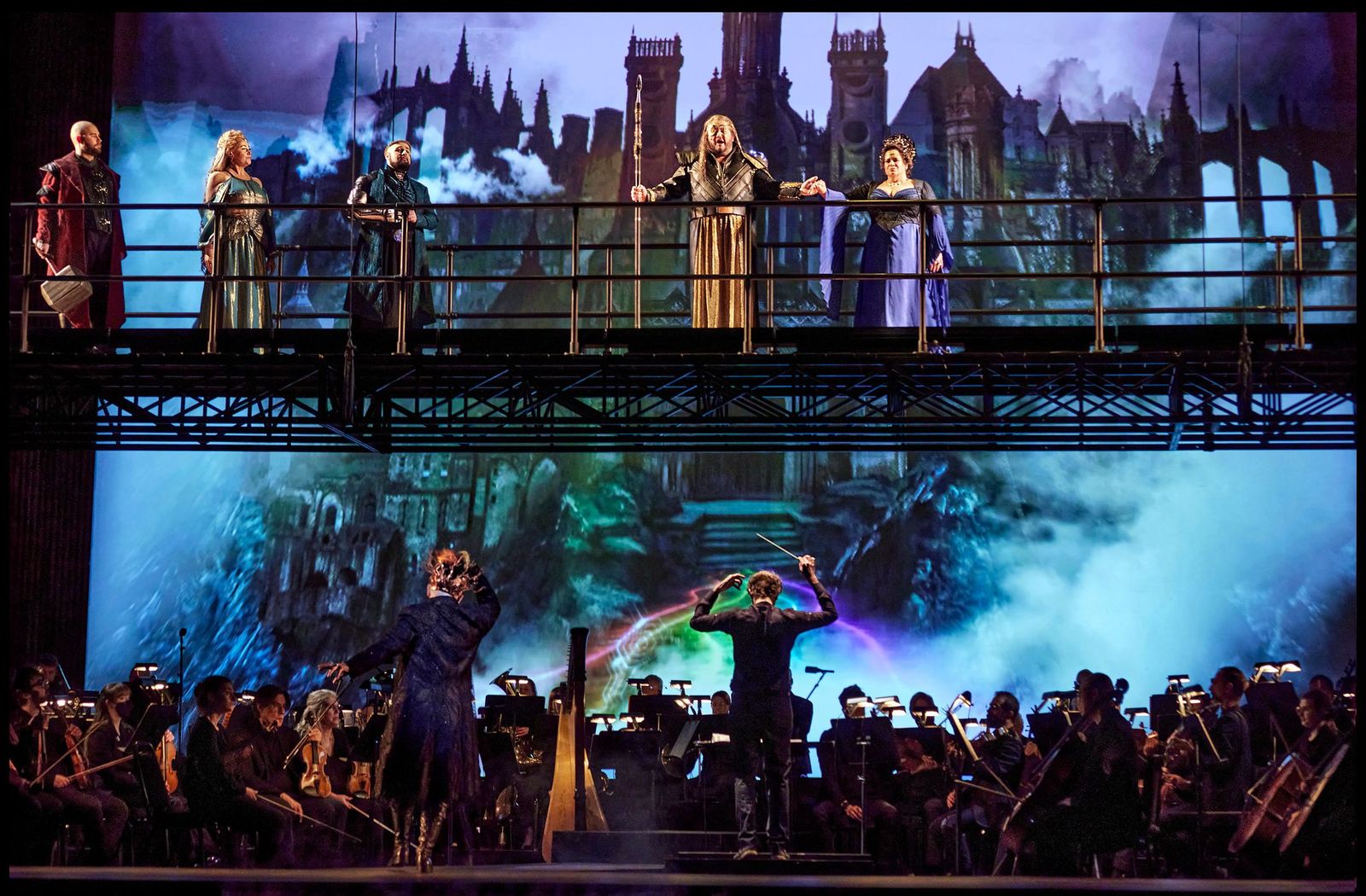Review by Mark Morris
Photos of production by HarderLee Photography
Wagner Das Rheingold
Calgary Opera
Director Brian Staufenbiel
Production concept Brian Staufenbiel
Calgary lighting Scott Reid
Costume design Mathew Lefebvre
Cast (In order of appearance):
Woglinde Juliana Krajčovič
Wellgunde Justine Ledoux
Flosshilde Yenny Lee
Alberich Boaz Daniel
Fricka Jill Grove
Wotan James Rutherford
Freia Anna Pompeeva
Fasolt Guido Jentjens
Fafner Kenneth Kellogg
Froh Elias Theocharidis
Donner Connor Hoppenbrouwers
Loge Rodell Rosel
Mime Gordon Gietz
Erda Catherine Daniel
Nibelungs Cantaré Children’s Choir
Calgary Philharmonic Orchestra
conducted by Jonathan Brandani
The Marvel universe has long appropriated the Norse gods for their fantasy comics and movies, with great success. Given that the 19th-century German composer Wagner took his inspiration for his masterpiece, the mythical cycle Der Ring des Nibelungen, from the 13th-century German epic Nibelungenlied, and that the Nibelungenlied was itself intertwined with those Norse legends, it seems a sort of logical circle to present a production in the style of that Marvel universe.
That’s what Calgary Opera decided to do, for the first ever Alberta production of Rheingold, the prelude to the cycle, using the designs and costumes created in 2016 by Minnesota Opera. That 2016 production, which has already been seen in Arizona, Seattle, and Montréal, was directed by Brian Staufenbiel, who was also responsible for the restaging at the Jubilee Auditorium. The production puts the orchestra on the stage, the lesser mortal action down in the pit (the Rhinemaidens, the Giants, and the Nibelungs), and the Gods on a bridge across the stage, with Loge wandering between all those areas.
Everything else – the general settings, Alberich as dragon, Donner’s thunderstoke, Valhalla, the rainbow bridge – are created by projections (with three depth levels), with many symbolic shapes, lighting effects, and scudding clouds.

How one reacts to all this depends, I think, on what one thinks about projections on an opera set – they can, after all, be either annoying, getting in the way of the staging, or a rather obvious way to save money. I personally really enjoyed this complex interplay of projection and light. The visual inventiveness was admirable, and by and large the symbolism did create a comprehensive fantastical world. The very large audience (the first night was sold out) clearly loved it, judging by their reaction at the end.
All was not, though, totally immersing. I have no idea what the strange round shield(?) with two vertical lines that flew in at times symbolized. The Rhinemaidens’ dreadful costumes seemed to have come not from a Marvel world, but from a 19th-century engraving of a provincial German production. Erda’s appearance, with twigs and sticks sticking out from head and fingers, unfortunately triggered for me memories of the horrific ordeal of Lavinia in Julie Taymor’s brilliant movie adaptation of Shakespeare’s Titus Andronicus. And Valhalla definitely needed a more imaginative architect, as it looked like a run-down version of Hogwart’s.
Most unfortunate were the costumes and staging of the two Giants, sung by Guido Jentjens and Kenneth Kellogg. They were given a sort of periscope video camera to converse with the Gods way above them. They were assigned almost no movement, and were costumed in what seemed, from the balcony, cast-offs from the Atlanteans in the British TV series Dr. Who. Their faces were projected in distortions on a small screen that flew in any time they arrived, and out when they left (unwittingly demonstrating the annoying side of projections). This staging destroyed any opportunity for tense and meaningful interaction with the Gods, and especially with Wotan, as the gold is piled up over Freia.


Similarly, I doubt anyone who did not know the opera would have realized that Mime was being whipped by his invisible master Alberich, so ineffectively was it staged.
Such moments apart, though, this production was alluring visually, the projections in constant motion, and a fine way for smaller companies like Calgary opera to present Rheingold, given that the Ring is an extraordinarily difficult and expensive undertaking theatrically. I have not seen the full Minnesota-designed Ring, and some of the visual symbolism may be clearer as the other operas in the cycle unfold – alas, Calgary Opera has, I understand, no plans to do the full Ring.
The Marvel-style staging should also appeal to younger audiences, providing a contemporary reference-point for such mythical fare, and to audiences who have never seen a Wagner opera before. There are lots of marvellous elements (no pun intended) – the different points of lighting for the gods, whether woven into the hair or built into a staff, for example, or the children of the Cantaré Children’s Choir reveling in playing the Nibelungs, scurrying around in the half-light, all clothed in grey.
Indeed, I found myself wanting more Marvel-type touches. Loge, surely, could have had his own fiery flashes – he is, after all, the god of fire – and Alberich as toad was the most feeble staging of this moment I have seen. The dragon was a little better, a fiery projection, more Tyrannosaurus Rex than the Norse dragon Nidhogg.
Of the cast, the most outstanding was James Rutherford as Wotan, authoritative vocally and in stage presence – his experience in the role (he first sang it at Oper Frankfurt in 2016) was the bedrock of this cast. As impressive was the young Edmontonian Connor Hoppenbrouwers as Donner, wielding a wonderfully huge wooden hammer – he studied at the University of Alberta, and is clearly a singer to watch. Ukrainian Soprano Anna Pompeeva, a forthright Freia, was the most convincing of the women. Another University of Alberta graduate, Catherine Daniel, whose singing I greatly admire, seemed slightly out of place as Erda, though that may have been because of my reaction, already noted, to her costume.

Disappointing, though, was the Alberich of Israeli Boaz Daniel. It’s not an easy singing-acting role, but it is a crucial one in the story of the Ring. He is not a nice character, and Daniel rather sang it as if he was. His curse of the ring, in particular, had little heightened emotion or tension – no wonder Wotan could just dismiss it.
That lack of bite was not entirely his fault, for the weakest aspect of this production, on this opening night at least, was undoubtedly what was going on in the orchestra. More than any other Romantic opera composer, Wagner uses the orchestra to be one of the main story-tellers (some would say the main) in his operatic world, especially through his use of leitmotivs. Rheingold abounds in them, some only embryonic, some more developed, but all setting up what is going to happen in the rest of the Ring cycle, and brilliantly commentating on what is happening in the stage action or the sung story.
Conductor Jonathan Brandani’s conducting suggested more an orchestra to support the singing (in the style of a classical or Italian opera), rather than a commanding presence in the mise en scène. The marvellous soundscape of the River Rhine that opens the the opera sounded sonorous, but the slow tempo lost the sense of the flow of the river. What was missing was bite and tension, not helped by the sometimes slow tempi, and there was little musical feel of the great events that were being set in motion.
The orchestra seemed to have picked up on this, as its playing was at times ragged, and rarely idiomatic. Yes, the orchestra was reduced, but it was more a question of approach and style than depth in numbers.
Such reductions are usually because of the size limitations of the pit. However, the orchestra was not in the pit, and there was room for more, even with budget restraints: for example, even one extra harp (if not the seven Wagner specified) would have added to a larger sound.
It may well be that this element of the production will improve in the further performances on Tuesday April 24 and Thursday April 26. I do hope so, for those new to Wagner or new to the Ring might go away with the impression that Rheingold is meant to sound like this orchestrally, whereas the opera’s sound world is richer than the first night of this production would suggest.
However, If you have never heard Wagner or Rheingold, do go and judge what it is all about for yourself, in particular to experience an imaginative theatrical production.
And if you have, what Wagnerian could miss any new production, especially of an opera that has finally arrived in Alberta.
Good for Calgary Opera for staging it. It will be interesting to compare with what is billed as a very different conception of the opera by Edmonton Opera at the end of May.
Wagner Das Rheingold
Calgary Opera
Southern Alberta Jubilee Auditorium
website
tickets: $40-$170


